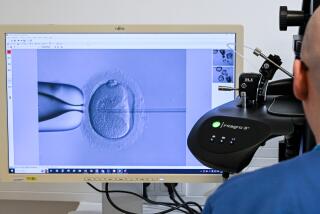Spawning a New Era? : Spurned by Nobel Laureates, Sperm Bank Has Lowered Its Sights Amid Ethical Questions
- Share via
ESCONDIDO — Ten years after the birth of the first baby from his sperm bank, Robert Graham has a 1 1/2-year waiting list of potential mothers, a wall full of pictures of beautiful children and a shortage of good men.
Although frustrated by the lack of tangible evidence that his theory holds up in real life, Graham remains captivated by the controversial notion that he can improve the human race by matching wanna-be mothers with the sperm of some of society’s most scholarly men.
“All nature asks is that we tilt the scales a little in its favor, and the babies will come out wonderful,” Graham said.
In 1981, he went public with his mission: creating the Repository for Germinal Choice. Based in Escondido, it would seek out the sperm of Nobel Prize winners to impregnate qualified women and then deliver what Graham considers better-bred babies--inherently brighter, more creative beings who would evolve into leaders and intellectuals, children who had it all going for them from the get-go.
The critical outcry--including from Nobel laureates--was swift and loud: How dare someone promote some sort of master race through the calculated marriage of sperm and egg? Only three Nobel winners donated sperm--and only one acknowledged his role: William B. Shockley, the Stanford physicist whose controversial theories correlating race and intelligence sparked protests and tainted Graham’s efforts.
Graham’s attempts to recruit more Nobel winners to donate sperm collapsed, so he lowered his sights and cast his net for men who are noted for their scholarly accomplishments, the kind of published scientists who are listed in “Who’s Who.”
No women ever chose a Nobel laureate’s sperm--the men were probably too old anyway, Graham rationalized later--and today there is no Nobel sperm in the bank.
Still, Graham has served as a middleman of sorts, a stork mail-order house, in the birth of 156 babies, from Escondido to Cairo. Eleven women are pregnant, and 150 more are trying. Many more are awaiting for more sperm to complete six-month quarantines as part of the screening and testing process to ensure that the sperm is free of the human immunodeficiency virus and genes for cystic fibrosis, Tay-Sachs and other diseases.
Last week was the 10th birthday of the first child, Victoria.
And Graham’s inability to track her down suggests that this wealthy optometrist/industrialist-turned-sperm broker, who made his fortune by inventing shatterproof lens for eyeglasses, might have difficulty measuring whether his theories are being manifested.
Victoria’s parents live somewhere in Texas, but Graham was unable to reach them, not even to wish his first sperm bank offspring a happy birthday--or find out how she is doing in school, or at the piano, or in dance or on the soccer field.
Last year, Graham sent out detailed questionnaires to the parents of the sperm bank offspring, hoping to assess his work.
“We had a very poor response,” Graham, 85, said. “Most of them simply wouldn’t answer.
“This project is in midstream. We’re getting positive results, but we won’t know for another 20 years if we’ve rung the bell and helped create better people.”
For some, there is no doubt.
Nine-year-old Doron Blake is the repository’s second child, borne by Los Angeles psychologist Afton Blake. At 2, he received his first computer; now he is on the brink of writing programs, slowed only by the tedious necessity of attending school, said his grandmother, Dr. Winafred Lucas.
“His tutor says he’s the most brilliant student she’s ever had, of any age, and that in two years he’ll be designing computer programs for businesses if he wants to,” Lucas said.
“Nobody puts pressure on this kid to succeed, because no one has to,” she said. “He was reading Shakespeare when he was 6, and discussed Hamlet with his uncle, who’s a screenwriter.
“I thought he should have some more age-appropriate books, so I got him the Black Stallion series. He liked it, but then he picked out Homer’s “Iliad” to read--the first version, in verse.”
Doron, who lives with his mother in Mt. Washington, is familiar with the notoriety surrounding him. He has been on the television news program “48 Hours” and last year was on the cover of California magazine.
“He gets $500 an hour when he’s interviewed,” his grandmother said. “Afton won’t allow him to be interviewed, and he won’t do it unless he’s paid. He hates doing interviews, but he does it like a little man. I’ve told him it’s like a job, and the money’s going to his college fund.”
Doron’s father, Lucas said, “is the top computer scientist in the country.”
The sperm of 13 men are on deposit at Graham’s office, stored in liquid nitrogen tanks until it is shipped for insemination. Donors are not paid, and Graham says he operates at a loss. The repository charges women shipping costs of $50 to $100, although Graham says he plans to raise the price soon to cover some of the testing.
The donors are coded by color.
“Mr. Orange-Red” is said to be a “graduate student involved in genetic research,” a fair-skinned, golden blond, 6-foot-4, 225-pound man with Austrian ancestry. “Very handsome, superb physique, warm, happy, confident” are listed as some of his traits. He enjoys martial arts and Ping-Pong, plays piano and “comes from a long line of talented professional individuals.”
Then there is “Mr. Grey-White,” a college letterman pursuing a doctorate who is 210 pounds, 6-foot-3, described as “ruggedly handsome, impressive presence, outgoing and positive.” He is accomplished in judo and chess, is an expert marksman and enjoys the classics.
The most sought-after donor at the repository is “Mr. Fuchsia.”
“He’s a biggie,” Graham said.
He is an Olympic gold medalist--but Graham will not say from the summer or winter Games--”who beat everybody in the world in his sport. Tall, dark, handsome, bright, a successful businessman and author. He’s got quite a lot on the ball,” Graham said.
Minorities are not represented, but Graham says that has not been for lack of effort. Only recently has the first Asian-American man agreed to donate sperm, and African-American and Latino men have refused him, he said.
Graham’s efforts bother some people who say the human race is not meant to be propagated and improved upon through such selective breeding.
“The scientific foundation for what the repository promotes--that by picking parents with certain genetic endowments we can create children more likely to have those genetic endowments--is flimsy,” said Arthur Caplan, director of the Center for Biomedical Ethics at the University of Minnesota.
“It seems we’re treating the baby as nothing more than the fulfillment of parental wishes. Yes, we want children to flourish and become who they are, but not by treating the child as a cluster of expectations,” Caplan said.
Graham responded: “We give childless couples a family, and the woman the best child she could have. We increase the offspring of some of our best men. And we give children the best possible start. All in one package.”






